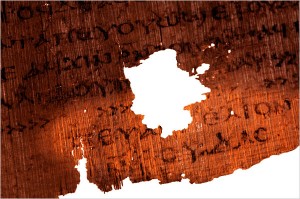(The following is a helpful post from Larry Hurtado)
Zetzel’s Observations on Textual Transmission
by larryhurtado
Although alerted to the book in an essay by Michael Holmes published in 1996, I confess that it is only in the last few days that I’ve got around to it: Latin Textual Criticism in Antiquity, by James E. G. Zetzel (Salem, NH: The Ayer company, 1984). I am very glad to have done so, even if tardy. For anyone concerned with the copying/transmission of NT writings (or, for that matter, any ancient writing), Zetzel offers some sage judgments backed up by solid observations of data. Here are a few samples of the wealth in Zetzel’s book. It was concerned with the transmission of classical works in Latin, but I’m convinced that his observations are relevant for NT studies as well.
Zetzel emphasizes that the copies of ancient literary works from which extant copies descend to us were likely those copied for readers who could afford to have them made, and that these readers were more often not scholars but simply interested individuals who wanted their own copies of the works. He also judges that, in the main, intentional changes in texts were more likely made by readers, rather than by copyists, which means that in understanding how texts got altered in antiquity, we need to give more attention to the readers and their situations. Quoting Zetzel (238-29), “In general, there is no escaping the disturbing fact that, in antiquity, the preservation and the quality of a text were the result of the interests of its successive owners or readers, not of a scholarly editor. Whether or not we have a careful or a sloppy text, an interpolated version or an accurate representation of the author’s original work, dpends entirely on the individuals whose copies have survived.”
I also found it striking that Zetzel distinguishes somewhat sharply between the fortunes of ancient texts that were treated as school texts and those that were not. Texts used in schools were much more frequently and widely read/studied and copied, and so “were the most protected texts” (239), which made it much more difficult for lines of such a text to be omitted or added without it being detected. So, for example, because Virgil was so widely used in schools from 19 BC onward, ” . . . the text is better preserved and more protected than that of any other ancient author” (247), although not immune to variants.
In an essay published in 2006 (“The New Testament in the Second Century: Text, Collections and Canon”), I contended that the frequent use of NT writings in early Christian circles (especially worship gatherings) had a somewhat similar effect, making it more difficult to change the texts markedly. (I’ve given the pre-publication version of the essay, and full facts on the published version on the “Essays, etc” page of this site, in the bullet-point “NT in the Second Century”.) So I find some confirmation of my argument in Zetzel’s that those pagan texts more often/widely used in schools were likewise more “protected”.
Here’s a final quotation from Zetzel (254) that I offer as one line of further research and reflection, perhaps especially by newer/younger scholars in NT studies: “Before we can even estimate the accuracy of our manuscripts, we must know the circumstances in which the text was read, and we must reconstruct, as far as possible, not the stemma of the text but the history of the influences that have acted upon the books from which our copies descend. It is not possible to do this in all cases, or even in many; but until it is attempted our understanding of both the ancient exts and their readers will be inaccurate.”












